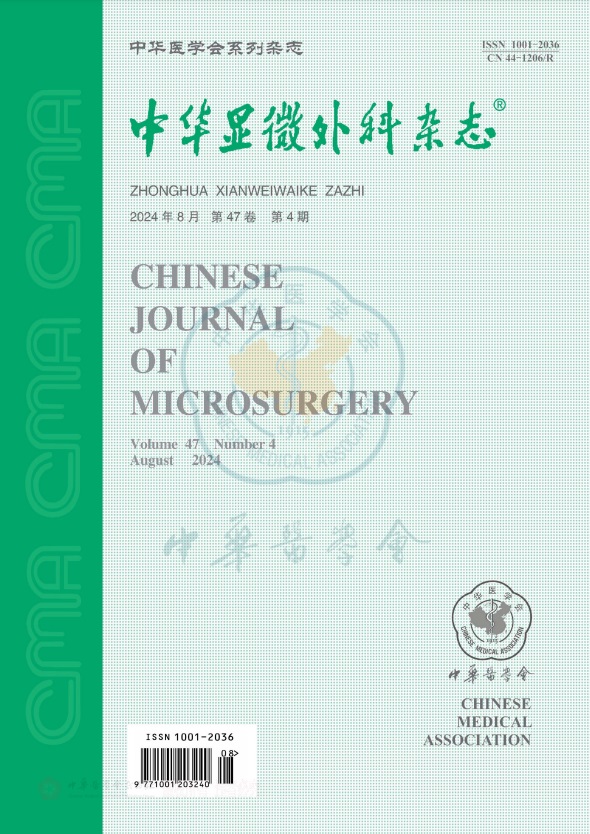Using the posterior tibial artery and peroneal artery perforator flaps to repair heel wounds: 18 cases report
引用次数: 0
Abstract
Objective To investigate the clinical efficacy of using the posterior tibial artery and peroneal artery perforator flaps to repair the heel wounds. Methods From January, 2011 to May, 2018, heel soft tissue defect caused by trauma in 18 cases were treated by posterior tibial artery and peroneal artery perforator flaps respectively. The posterior tibial artery perforator flap was used in 11 cases, and the peroneal artery perforator flap was used in 7 cases. The area of flaps ranged from 5.0 cm×3.0 cm to 11.0 cm×9.0 cm. The length of the vascular pedicle was from 10.0 cm to 16.0 cm. After operation, the patients were followed-up regularly. The time of wound healing, appearance and texture of the flap, and function of ankle joint were observed. Results After the operation, 13 flaps survived uneventfully. The wound achieved primary healing. Partial necrosis occurred in the distal of posterior tibial artery perforator flap in 2 cases, and repaired by skin graft 1 or 2 months later. Marginal necrosis occurred in posterior tibial artery perforator flap in 2 cases and in peroneal artery perforator flap in 1 case. And scar healing occurred in these 3 cases finally. All the 18 patients were followed-up for 3 to 60 months, with an average of 10 months. Fracture healing time was from 3-6 months, with an average of 4 months. Flap was soft with satisfied appearance in 16 cases. Obvious scar formation occurred in 2 cases. There was no obvious scar contracture in donor sites. There was no obvious limitation of the flexion and extension function of the ankle joint in 18 cases. According to the American Orthopaedic Foot and Ankle Society (AOFAS) ankle-hindfoot score, there was excellent in 16 cases, and good in 2 cases. Conclusion As for the characteristics of the heel wound, it is a simple and practical method to use leg perforator flap to repair. The flap is based on a long vascular pedicle. And the clinical effect is satisfied. Key words: Posterior tibial artery; Peroneal artery; Perforator flap; Heel; Repair胫后动脉和腓骨动脉穿支皮瓣修复足跟创伤18例报告
目的探讨应用胫后动脉-腓动脉穿支皮瓣修复足跟部创伤的临床疗效。方法自2011年1月至2018年5月,对18例外伤性足跟软组织缺损患者分别采用胫后动脉和腓动脉穿支皮瓣进行治疗。胫后动脉穿支皮瓣11例,腓动脉穿支瓣7例。皮瓣面积5.0cm×3.0cm~11.0cm×9.0cm,血管蒂长度10.0cm~16.0cm,术后定期随访。观察创面愈合时间、皮瓣外观、质地及踝关节功能。结果术后13个皮瓣均顺利成活。伤口已初步愈合。胫后动脉穿支皮瓣远端部分坏死2例,1、2个月后用植皮修复。胫后动脉穿支皮瓣边缘坏死2例,腓动脉穿支瓣边缘坏死1例。3例患者最终均出现瘢痕愈合。18例患者均随访3~60个月,平均随访10个月。骨折愈合时间3-6个月,平均4个月。皮瓣柔软,外形满意16例。2例出现明显瘢痕形成。供区无明显瘢痕挛缩。18例踝关节屈伸功能无明显限制。根据美国足踝矫形学会(AOFAS)踝后足评分,优16例,良2例。结论针对足跟部创伤的特点,采用穿支皮瓣修复足跟部损伤是一种简单实用的方法。皮瓣是基于一个长的血管蒂。临床效果令人满意。关键词:胫后动脉;腓动脉;穿孔皮瓣;鞋跟;修理
本文章由计算机程序翻译,如有差异,请以英文原文为准。
求助全文
约1分钟内获得全文
求助全文
来源期刊
CiteScore
0.50
自引率
0.00%
发文量
6448
期刊介绍:
Chinese Journal of Microsurgery was established in 1978, the predecessor of which is Microsurgery. Chinese Journal of Microsurgery is now indexed by WPRIM, CNKI, Wanfang Data, CSCD, etc. The impact factor of the journal is 1.731 in 2017, ranking the third among all journal of comprehensive surgery.
The journal covers clinical and basic studies in field of microsurgery. Articles with clinical interest and implications will be given preference.

 求助内容:
求助内容: 应助结果提醒方式:
应助结果提醒方式:


